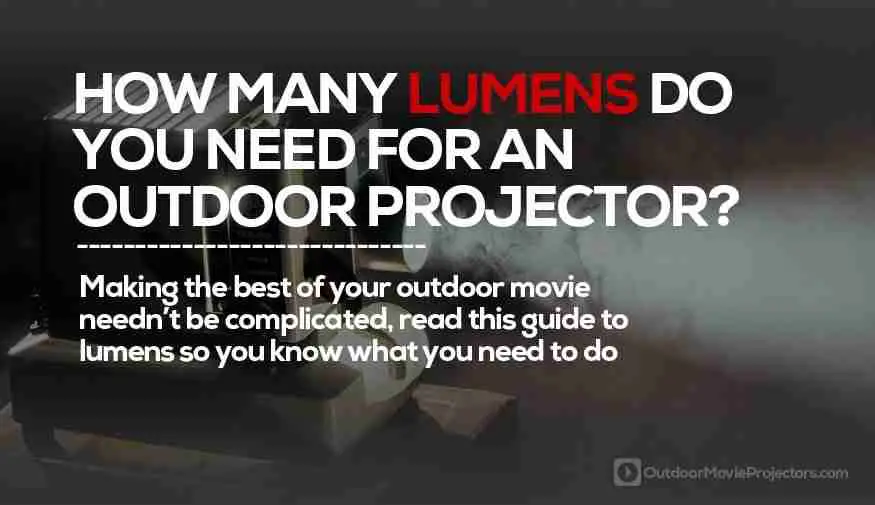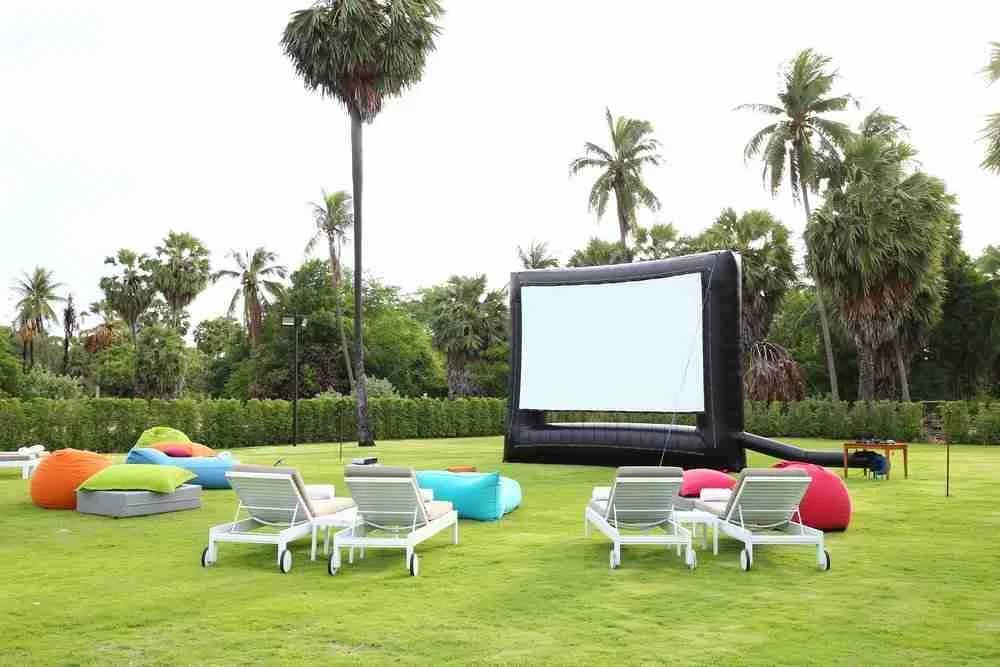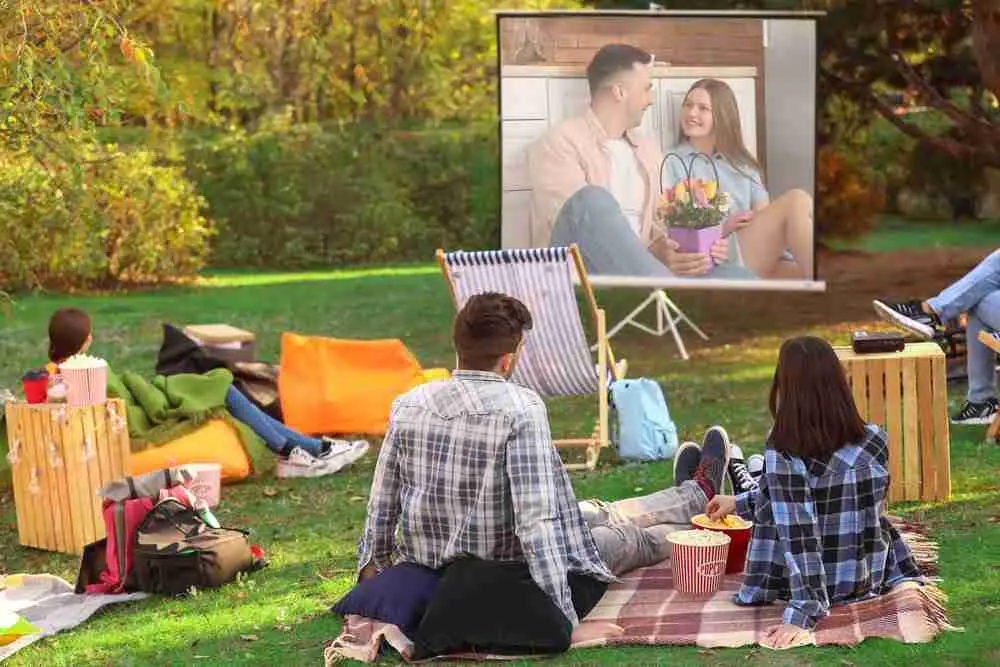If you are just starting out with backyard movies and outdoor projectors then you might have heard about lumens, and how you should be calculating how many you need to achieve the very best picture.
In simple terms, a lumen is a measurement of the intensity of light radiation projected by a light source.
With outdoor projectors, you want something that is bright enough so that the images are sharp and easy to see in ambient light conditions.
Please note: If you want to know the best lumens for a projector, and what type you need to buy depending on your screen size and pans, then read this latest blog post.
In other words, you don’t want to have to turn downlights in the backyard just so your guests can see the screen, as chances are they will be stumbling around in the dark and could be put at risk of injury.
I always advise that when running an outdoor movie night, you keep some lighting on, and have a bright projector that won’t be affected by those ambient light sources.
Making the best of your backyard movie means you might want to consider the best possible projector given how large your screen will be.
But let me be 100% honest with you.
For the average person building their own backyard movie screen you don’t need to get too concerned about how many lumens you will need.
It’s not going to be massively important to know if your outdoor projector is going to be bright enough as it probably will be.
Calculating how many lumens an outdoor projector needs is an overkill for the majority of people wanting to show movies in their backyard.
But, given you’ve come here to find out, I will show you a calculation that you can use to do so, but seriously, I probably wouldn’t waste too much time on this. The most important part about your outdoor movie night is to have fun.
Calculating lumens and the difference it could make is probably going to be minimal, and only something a very technical person with a background in video production might want to consider.
In most cases, the projector you buy will be bright enough due to current standards that manufacturers work to. If it’s a piece of modern kit, it should be fine.
The bottom line should always be: are you pleased with the picture on your screen?
This table will also help you in deciding what lumen-rating projector you should buy:
| Screen Size | Minimum Lumen Needed | Ideal Lumens Needed |
|---|---|---|
| 9x5 foot | 1,500 | 2,300 |
| 12x7 foot | 2,300 | 3,000 |
| 16x9 foot | 3,000 | 4,500 |
| 20x11 foot | 4,500 | 7,500 |
| 25x14.5 foot | 5,000 | 10,000 |
| 40x22.5 foot | 5,500 | 12,000 |
Calculating Lumens to See if Your Outdoor Projector is Bright Enough
So without further ado, here’s how you calculate lumens for an outdoor projector. Having a bright and clear picture on your outdoor movie screen is the nirvana of backyard movie nights. Is your projector bright enough could possibly be a concern, and one way in which you can find out is;
- a) simply looking at it, or…
- b) finding out how many lumens you need
This is a very rough guide to calculating lumens, as there are other factors that will come into play when determining how bright your screen is.
Other factors will include:
- The material your screen is made from
- Ambient light sources present
- How old your projector bulb or lamp is
- The settings on your outdoor projector
Here’s my way of calculating how many lumens you will need to light up your screen size when showing movies in ideal conditions.
What are Foot-Lumens?
Also known as foot-lamberts, these are a measurable unit that has become a standard in the movie industry to specify how much light should be reflected off the screen at a 1×1 foot area.
The Society of Motion Picture and Television Engineers (SMPTE) recommends 16 foot-lamberts in a dark movie theater. A general rule of thumb is that acceptable values range from 12 to 22 foot-lamberts (for projected images).
Now when it comes to your own backyard movie, lower values might suffice and could be just fine for what you are looking to achieve from quality of image perspective.
The Calculation Formula
To calculate foot-lamberts I am going to assume that the projector you own is at the same aspect ratio as the outdoor screen you are projecting the movie onto.
Foot-lamberts = Lumens / Screen Area (in square feet)
In a real-world example that might be something like this:
Your screen is 16 feet wide, and 9 feet high. To get your screen area you multiply them both together which gives 16 x 9 = 144 square feet.
If you are using an outdoor projector which is 2000 lumens then what you then do is:
2,000 (your projector lumens) / 144 (your screen area) = 13.9 foot-lamberts
The final figure of 13.9 foot-lamberts is then sitting inside of the recommended range of 12 to 22 foot-lamberts meaning it’s looking good!
If you then want to calculate how many lumens you need to achieve the ideal SMPTE brightness for your screen you simply adjust the example above using the following calculation:
144 (sq. ft. of your screen) x 16 (ideal SMPTE foot-lamberts) = 2,304 lumens
Therefore, 2,304 lumens are the ideal value for a 16′ x 9′ screen (in the dark and outdoors).
My Conclusion
Let me be clear, this is a very rough guide to calculating how many lumens you need. Most people won’t even need to worry about it.
If your projector and screen are at differing ratios, then this formula will not work and won’t give accurate results, unfortunately.
But at the very least I hope this calculation gives you a rough idea of how many lumens you will need if indeed this is important to you.




